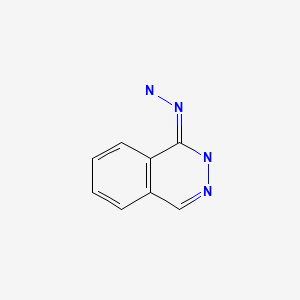Attribution Statement: LactMed is a registered trademark of the U.S. Department of Health and Human Services.
NCBI Bookshelf. A service of the National Library of Medicine, National Institutes of Health.
Drugs and Lactation Database (LactMed®) [Internet]. Bethesda (MD): National Institute of Child Health and Human Development; 2006-.
CASRN: 86-54-4

Drug Levels and Effects
Summary of Use during Lactation
Limited milk level and infant serum level data and a long history of use in postpartum mothers indicate that hydralazine is an acceptable antihypertensive in nursing mothers, even those nursing newborns.
Drug Levels
Maternal Levels. In one case report, a mother taking oral hydralazine 50 mg 3 times daily for at least 8 weeks postpartum had hydralazine milk levels of about 130 mcg/L at 0.5 and 2 hours after a dose. In addition, milk contained an amount of acid-labile hydrazones with undefined pharmacologic activity. The authors estimated that a breastfed infant would receive a maximum of 13 mcg per feeding at this maternal dosage.[1]
Ten lactating women had blood and breastmilk samples analyzed within 24 hours after receiving a dose of hydralazine of between 10 and 40 mg in the first week postpartum. The analytic method measured hydralazine plus its pharmacologically active acid-labile metabolites. The average concentration of drugs in breastmilk was 240 nmol/L, which was about half of the simultaneous concentration in maternal plasma. The authors estimated that the daily dose to a breastfed infant would likely not exceed 25 mcg.[2]
Infant Levels. Two infants were breastfed after their mothers had received a dose of hydralazine between 10 and 40 mg during the first week postpartum., At 2 hours after feeding, infant serum drug concentrations were 557 and 293 nmol/L. The analytic method measured hydralazine plus its pharmacologically active acid-labile metabolites. These values were much lower than those found in a 2 kg infant who was receiving hydralazine 6 mg/kg daily directly for coarctation of the aorta. Serum levels in this infant were 6230 nmol/L before a 4 mg dose, and 8050 and 8310 nmol/L at 2 and 4 hours after the dose, respectively. Two other infants who received sterilized (100 degrees C for 10 minutes) breastmilk from their mothers who were taking hydralazine had no detectable hydralazine in their serum 2 hours after receiving the breastmilk feeding. The authors showed that expressed milk concentrations from 2 mothers were 140 nmol/L before heating and <20 nmol/L after heating.[2]
Effects in Breastfed Infants
No adverse effects reported in one infant breastfed for 8 weeks.[1]
Effects on Lactation and Breastmilk
Relevant published information was not found as of the revision date.
Alternate Drugs to Consider
References
- 1.
- Liedholm H, Wahlin-Boll E, Hanson A, et al. Transplacental passage and breast milk concentration of hydralazine. Eur J Clin Pharmacol. 1982;21:417–9. [PubMed: 7200428]
- 2.
- Lamont RF, Elder MG. Transfer of hydralazine across the placenta and into breast milk. J Obstet Gynaecol. 1986;7:47–8. [PubMed: 29480117]
Substance Identification
Substance Name
Hydralazine
CAS Registry Number
86-54-4
Disclaimer: Information presented in this database is not meant as a substitute for professional judgment. You should consult your healthcare provider for breastfeeding advice related to your particular situation. The U.S. government does not warrant or assume any liability or responsibility for the accuracy or completeness of the information on this Site.
- User and Medical Advice Disclaimer
- Drugs and Lactation Database (LactMed) - Record Format
- LactMed - Database Creation and Peer Review Process
- Fact Sheet. Drugs and Lactation Database (LactMed)
- Drugs and Lactation Database (LactMed) - Glossary
- LactMed Selected References
- Drugs and Lactation Database (LactMed) - About Dietary Supplements
- Breastfeeding Links
- PubChem SubstanceRelated PubChem Substances
- PubMedLinks to PubMed
- Review Isocarboxazid.[Drugs and Lactation Database (...]Review Isocarboxazid.. Drugs and Lactation Database (LactMed®). 2006
- Review Pimozide.[Drugs and Lactation Database (...]Review Pimozide.. Drugs and Lactation Database (LactMed®). 2006
- Review Tranylcypromine.[Drugs and Lactation Database (...]Review Tranylcypromine.. Drugs and Lactation Database (LactMed®). 2006
- Review Dextromethorphan.[Drugs and Lactation Database (...]Review Dextromethorphan.. Drugs and Lactation Database (LactMed®). 2006
- Review Pyrazinamide.[Drugs and Lactation Database (...]Review Pyrazinamide.. Drugs and Lactation Database (LactMed®). 2006
- Hydralazine - Drugs and Lactation Database (LactMed®)Hydralazine - Drugs and Lactation Database (LactMed®)
Your browsing activity is empty.
Activity recording is turned off.
See more...
